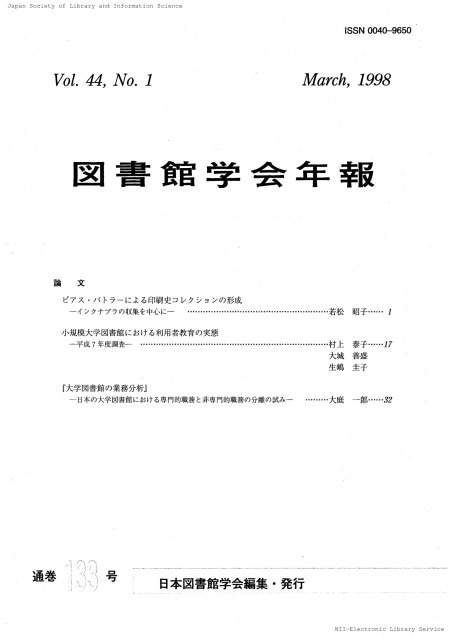All issues

Volume 41, Issue 2
Displaying 1-7 of 7 articles from this issue
- |<
- <
- 1
- >
- >|
Article
-
Kazuaki KISHIDA, Masaya TAKAYAMA, Hiroshi ITSUMURA, Takashi HARADA, Ha ...Article type: Article
1995 Volume 41 Issue 2 Pages 49-65
Published: 1995
Released on J-STAGE: November 10, 2021
JOURNAL FREE ACCESSThe relationship between in-library use and circulation is very important for library management. This paper studies empirically the relationship by examining about 110,000 records of in-library use in two Japanese academic libraries. As a result of this study, it is clear that the number of circulation can be a reliable predictive indicator of the number of in-library use. For example, seasonal variation of in-library use, synchronous obsolescence of in-library use and the number of in-library use by disciplines, are predictable by regression models in which the number of circulation is an independent variable. The coefficients of determination of the models are, in turn, 0.87, 0.94, 0.85, respectively, which indicate very high correlation between in-library use and circulation. It is also clarified, however, that there are some systematic errors by the models, that is, some factors cause systematically underestimation or overestimation of in-library use.View full abstractDownload PDF (1789K) -
Madoko KONArticle type: Article
1995 Volume 41 Issue 2 Pages 67-80
Published: 1995
Released on J-STAGE: November 10, 2021
JOURNAL FREE ACCESSAfter the World War II, Japan was occupied by the Supreme Commander of the Allied Powers=SCAP. Civil Information and Education Section=CIE of the SCAP/GHQ set up twenty three information centers [libraries] in larger cities for the use of Japanese citizens as part of the occupation program.
As weekly reports of information centers in Fukuoka, Nagasaki and Kumamoto were found in CIE records, numbers of users, holdings, circulation, library tours, storytelling, movies and record concerts were revealed. American librarians' names and their terms, and location of branches of centers were also known.View full abstractDownload PDF (1568K) -
Shuichi UEDAArticle type: Article
1995 Volume 41 Issue 2 Pages 81-88
Published: 1995
Released on J-STAGE: November 10, 2021
JOURNAL FREE ACCESSThe mail survey of OPACs in Japanese university libraries (return rate is 84.9%) shows that 60.4% of university libraries in Japan installed OPAC and 74.5% of it freezed card catalog. Most of OPACs in Japanese university libraries linked the automated circulation system, but OPACs connected internet were only 6.5%.View full abstractDownload PDF (724K)
-
[in Japanese]1995 Volume 41 Issue 2 Pages 66
Published: 1995
Released on J-STAGE: November 10, 2021
JOURNAL FREE ACCESSDownload PDF (120K) -
[in Japanese]1995 Volume 41 Issue 2 Pages 92-2
Published: 1995
Released on J-STAGE: November 10, 2021
JOURNAL FREE ACCESSDownload PDF (114K)
-
1995 Volume 41 Issue 2 Pages 89-92-1
Published: 1995
Released on J-STAGE: November 10, 2021
JOURNAL FREE ACCESSDownload PDF (488K) -
1995 Volume 41 Issue 2 Pages 93-96
Published: 1995
Released on J-STAGE: November 10, 2021
JOURNAL FREE ACCESSDownload PDF (499K)
- |<
- <
- 1
- >
- >|